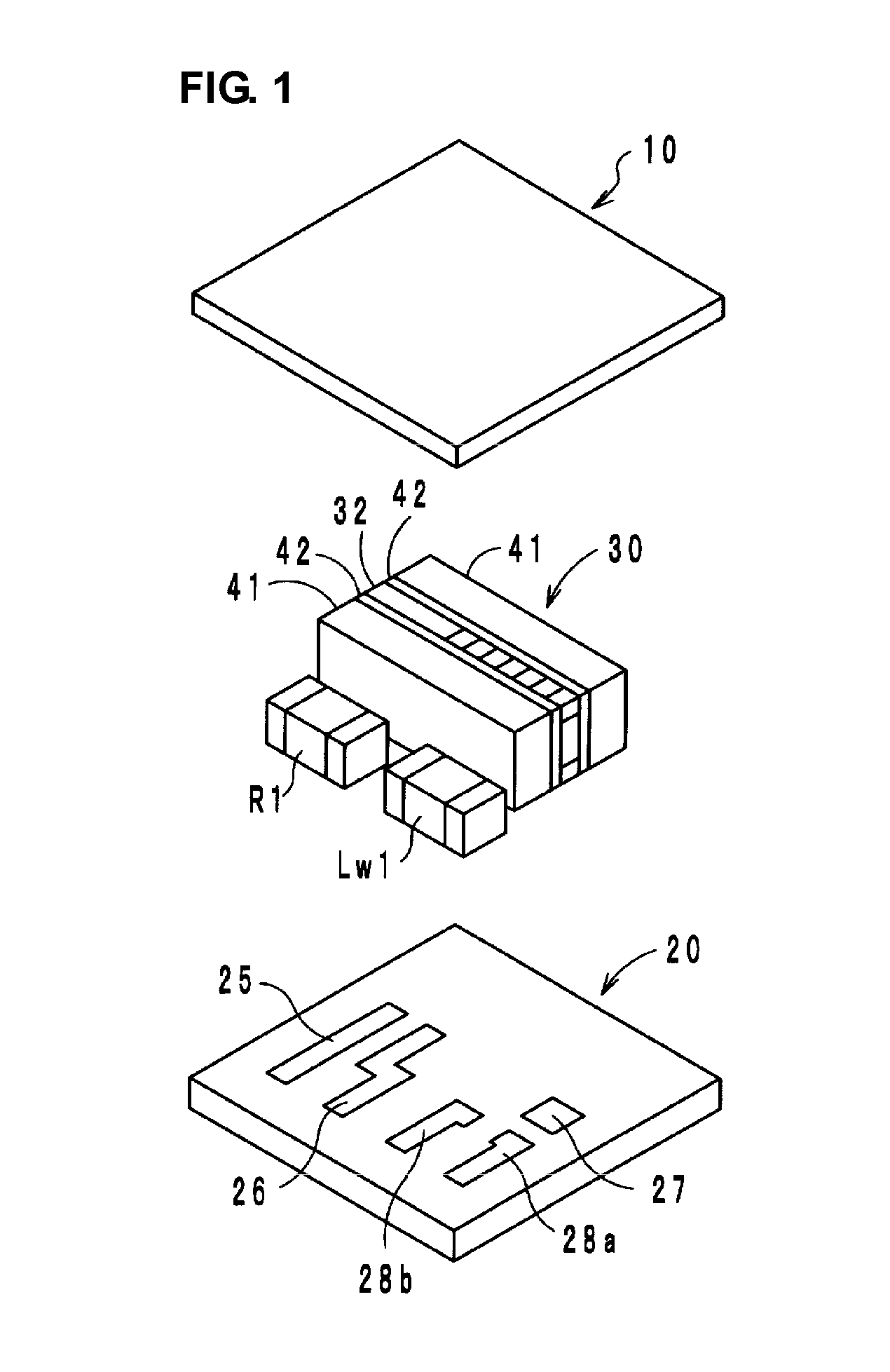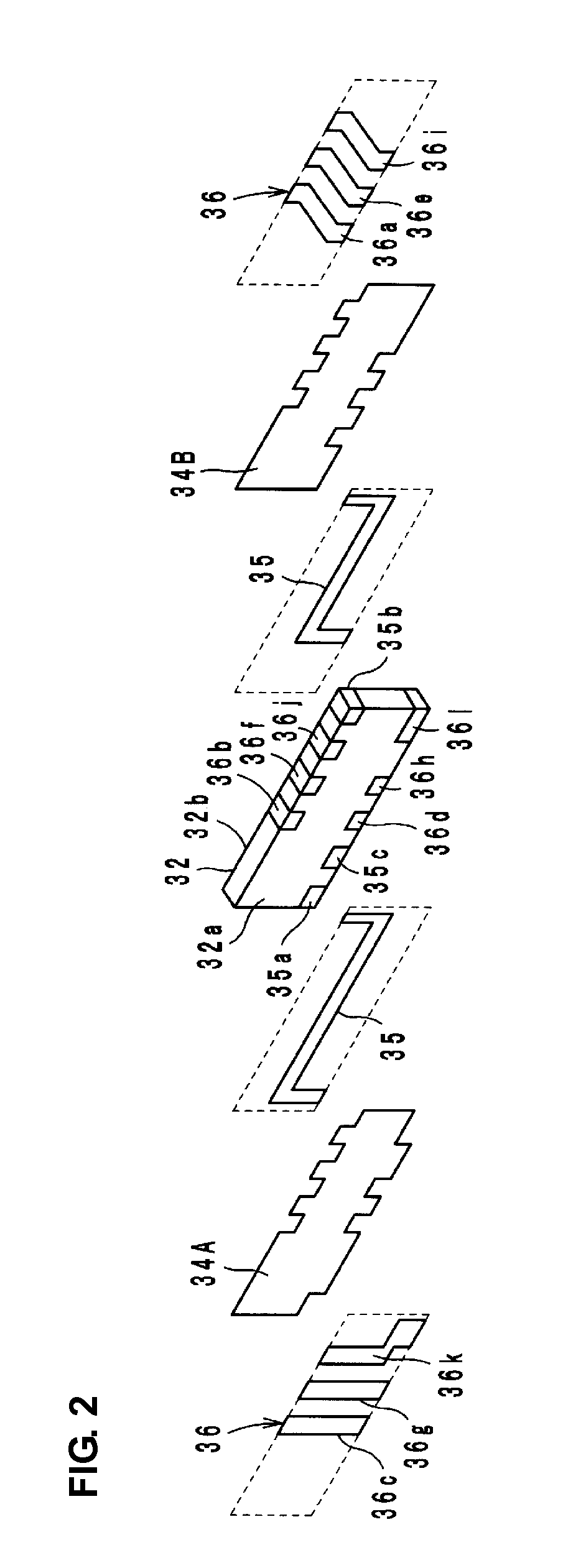Nonreciprocal circuit element
a non-reciprocal, circuit element technology, applied in the direction of basic electric elements, waveguide devices, electrical equipment, etc., can solve the problems of increasing product size and cost, difficult to stably mass-produce non-reciprocal circuit elements having the desired characteristic, etc., to achieve the effect of improving isolation characteristics, increasing reliability, and not increasing insertion loss
- Summary
- Abstract
- Description
- Claims
- Application Information
AI Technical Summary
Benefits of technology
Problems solved by technology
Method used
Image
Examples
first preferred embodiment
[0025]A nonreciprocal circuit element (two-port isolator) according to the first preferred embodiment preferably is a lumped-constant isolator, and includes a circuit board 20, a ferrite-magnet assembly 30 including a ferrite 32 and a pair of permanent magnets 41, a substantially planar yoke 10, a chip resistor R1, and a chip inductor Lw1 as illustrated in FIG. 1.
[0026]As illustrated in FIG. 2, in the ferrite 32, a first center electrode 35 and a second center electrode 36 are electrically insulated from each other by an insulating material 34A on a first main surface 32a, and the first center electrode 35 and the second center electrode 36 are electrically insulated from each other by an insulating material 34B on a second main surface 32b. The ferrite 32 preferably has a substantially rectangular parallelepiped shape, for example, including the first main surface 32a and the second main surface 32b that face each other and are parallel or substantially to each other.
[0027]The perm...
second preferred embodiment
[0054]As illustrated in an equivalent circuit diagram in FIG. 6, a nonreciprocal circuit element (two-port isolator) according to the second preferred embodiment is preferably substantially the same as that according to the first preferred embodiment except that an inductor Lw2 is preferably used as an element to connect the LC parallel resonant circuits 51 and 52. Accordingly, in the second preferred embodiment, operational effects and advantages similar to that obtained in the first preferred embodiment can be obtained.
[0055]An insertion loss characteristic and an isolation characteristic of a two-port isolator according to the second preferred embodiment will be described with reference to FIGS. 7 and 8. An insertion loss characteristic and an isolation characteristic are based on pieces of data of measurement performed on a two-port isolator having the following specifications.[0056]Inductor L1: approximately 2.50 nH[0057]Inductor L2: approximately 6.60 nH[0058]Capacitor C1: app...
third preferred embodiment
[0068]As illustrated in an equivalent circuit diagram in FIG. 9, a nonreciprocal circuit element (two-port isolator) according to the third preferred embodiment is preferably substantially the same as that according to the second preferred embodiment except that two capacitors Cw11 and Cw12 are used instead of the capacitor Cw1 in the LC parallel resonant circuit 51. Accordingly, in the third preferred embodiment, operational effects and advantages described in the first preferred embodiment can be obtained.
[0069]There is a certain variation in a capacitance value of a capacitor. The variation in a capacitance value in a case where two capacitors are used is smaller than that in a case where a single capacitor is used. The reason for this is that, when a capacitance value standard deviation in a case where n capacitors are used is calculated under the assumption that the distribution of the variation in a capacitance value of a single capacitor is a normal distribution and a capacit...
PUM
 Login to View More
Login to View More Abstract
Description
Claims
Application Information
 Login to View More
Login to View More - R&D
- Intellectual Property
- Life Sciences
- Materials
- Tech Scout
- Unparalleled Data Quality
- Higher Quality Content
- 60% Fewer Hallucinations
Browse by: Latest US Patents, China's latest patents, Technical Efficacy Thesaurus, Application Domain, Technology Topic, Popular Technical Reports.
© 2025 PatSnap. All rights reserved.Legal|Privacy policy|Modern Slavery Act Transparency Statement|Sitemap|About US| Contact US: help@patsnap.com



